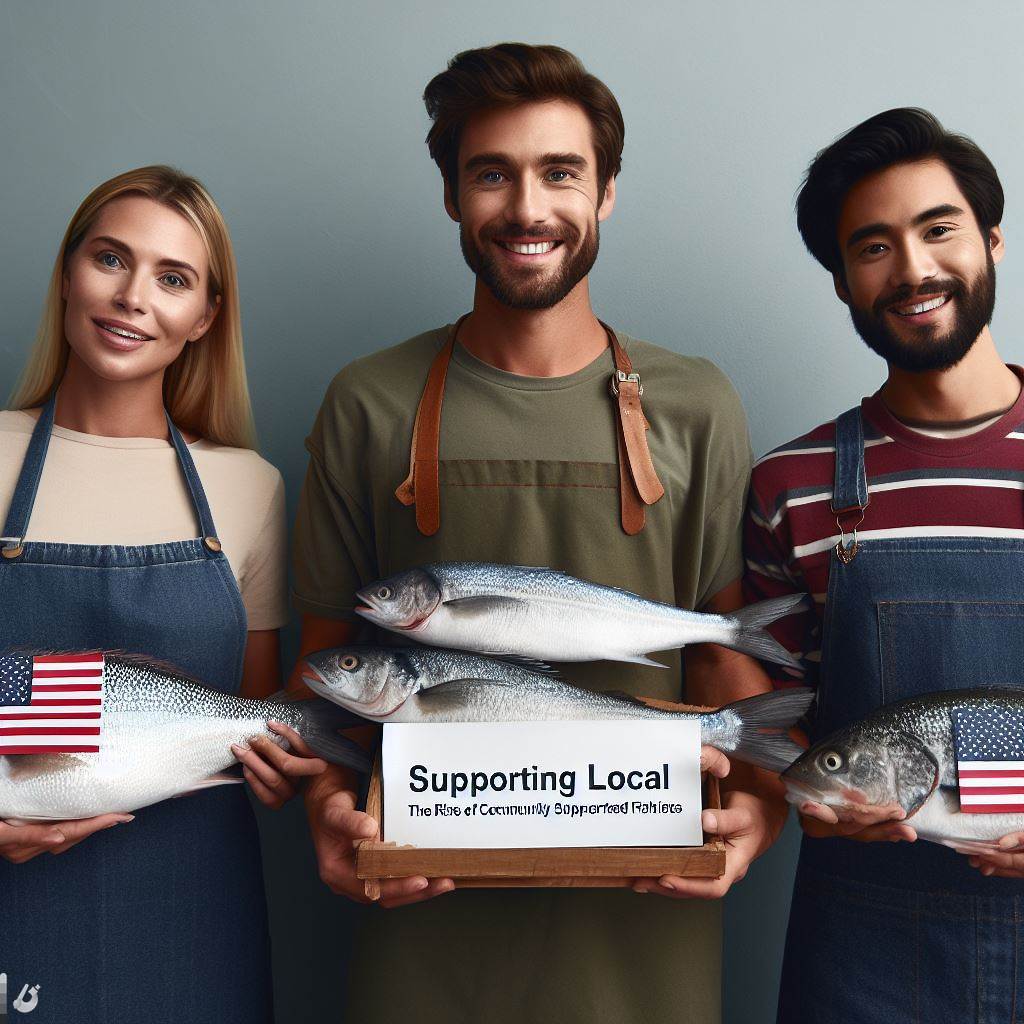Introduction
Community Supported Fisheries (CSFs) are a way for consumers to connect directly with local fishermen.
These programs allow individuals to purchase shares of a harvest and receive fresh, sustainably caught seafood.
CSFs have gained popularity in recent years due to several factors.
Firstly, consumers are becoming more conscious of where their food comes from and are seeking out local options.
CSFs provide a direct link between the consumer and the fisherman, ensuring transparency and traceability.
Additionally, CSFs support local businesses and fishing communities.
By purchasing seafood directly from local fishermen, consumers are contributing to the local economy and helping to sustain these communities.
This is particularly important in coastal areas where fishing is a traditional way of life.
Another reason for the rise in popularity of CSFs is the growing concern for sustainable fishing practices.
Overfishing and destructive fishing methods have had a detrimental impact on marine ecosystems.
CSFs promote responsible fishing practices, such as using selective gear and avoiding overfished species, to ensure the long-term health and abundance of marine resources.
Most Importantly, CSFs offer a unique opportunity for consumers to support local businesses and sustainable fishing practices.
By participating in CSFs, individuals can enjoy fresh seafood while making a positive impact on the environment and local communities.
It is essential to continue promoting and advocating for CSFs as a way to build resilient and sustainable food systems.
The Concept of Community-Supported Fisheries
Brief history and background of CSFs
- Community Supported Fisheries (CSFs) have gained popularity in recent years to support local fishers.
- The concept originated from the Community Supported Agriculture (CSA) model.
- CSFs aim to create a direct connection between fishers and consumers.
How CSFs work
- In CSFs, consumers become members by subscribing or purchasing shares directly from the fishers.
- Members receive a share of the catch regularly throughout the fishing season.
- Fishers use sustainable and responsible fishing practices, ensuring high-quality seafood for their members.
- CSFs often provide a variety of fish species, reflecting the local marine biodiversity.
- The catch is delivered to convenient pick-up locations or directly to the member’s doorstep.
Benefits of participating in CSFs for both fishers and consumers
- Fishers receive fair prices for their catch, eliminating the need for intermediaries.
- Direct sales through CSFs help fishers maintain their livelihoods and support their communities.
- By participating in CSFs, consumers support local fishers and contribute to the local economy.
- Consumers gain access to fresh, locally sourced seafood that is traceable back to its source.
- Members have the opportunity to connect with fishers, learning about their fishing practices and challenges.
- CSFs promote sustainable fishing methods and help protect marine ecosystems.
- Members have the chance to try a variety of fish species they may not find in regular supermarkets.
- CSFs encourage a closer relationship between fishers and consumers, fostering a sense of community.
- Supporting local fishers reduces the carbon footprint associated with long-distance seafood transportation.
- Participating in CSFs allows consumers to make informed choices and support ethical and transparent fishing practices.
- Members can provide feedback, influencing future fishing practices and species selection.
In fact, Community Supported Fisheries (CSFs) have emerged as a successful model to support local fishers and provide consumers with fresh and traceable seafood.
By participating in CSFs, both fishers and consumers benefit from fair prices, sustainable fishing practices, community support, and a closer connection with the local environment.
CSFs not only contribute to the local economy but also promote the conservation of marine ecosystems and enable consumers to make responsible seafood choices.
Joining a CSF not only ensures the availability of high-quality seafood but also fosters a sense of community and belonging.
Read: How Overfishing Affects US Waters and Solutions Ahead
Environmental Impact of Community-Supported Fisheries
In this section, we will discuss the negative effects of traditional fishing practices and how Community Supported Fisheries (CSFs) promote sustainable fishing methods.
Transform Your Career Today
Unlock a personalized career strategy that drives real results. Get tailored advice and a roadmap designed just for you.
Start NowWe will also provide examples of successful CSFs that have played a significant role in preserving marine ecosystems.
Negative Effects of Traditional Fishing Practices
- Overfishing: Many traditional fishing practices prioritize high catch rates, leading to the depletion of fish populations.
- Bycatch: In conventional fishing, non-target species, such as dolphins, turtles, and seabirds, get caught unintentionally.
- Habitat Destruction: Bottom trawlers and dredging equipment used in traditional fishing can damage important marine habitats.
- Unsustainable Gear: Traditional fishing often employs gear like gillnets and longlines that can harm marine life indiscriminately.
- Pollution: Large-scale fishing operations release oil, plastics, and other pollutants into the ocean, harming both marine life and the environment.
These practices have had a severe impact on marine ecosystems, threatening biodiversity and the long-term health of our oceans.
Promoting Sustainable Fishing Methods through CSFs
Community Supported Fisheries have emerged as a solution to the environmental problems caused by traditional fishing practices.
They promote the following sustainable methods:
- Small-Scale Operations: CSFs mostly involve small-scale, locally based fishermen who use low-impact fishing techniques.
- Selective Fishing: CSFs employ selective fishing gear and methods that target specific species, reducing bycatch.
- Seasonal Fishing: By adhering to seasonal fishing limits, CSFs allow fish populations to replenish, ensuring their long-term survival.
- Locally Sourced Feed: CSFs feed their fish with locally sourced, sustainable feed, reducing dependence on unsustainable fishmeal.
- Ecosystem-Based Management: CSFs consider the entire ecosystem when making fishing decisions, prioritizing its health and balance.
The focus on sustainability in CSFs helps protect marine biodiversity while ensuring the livelihoods of fishermen and the availability of fresh seafood for local communities.
Successful CSFs in Preserving Marine Ecosystems
Several CSFs worldwide have made remarkable contributions to preserving marine ecosystems:
- Pacific Coast Groundfish Project: This CSF has successfully revived several overfished species, thanks to responsible fishing practices and tight regulations.
- Thames Estuary CSF: By involving local fishermen in conservation efforts, this CSF has helped restore crucial habitats and revive fish populations in the UK.
- Port Clyde Fresh Catch: This CSF supports the use of traps instead of trawls, significantly reducing damage to the ocean floor and preventing bycatch.
- Nereide CSF, Italy: By practicing sustainable fishing methods, this CSF has helped protect the Posidonia oceanica meadows in the Mediterranean.
- Organic Ocean, Canada: This CSF uses selective fishing gear and sustainable practices to provide consumers with seafood while preserving marine ecosystems.
These CSFs demonstrate that it is possible to foster sustainable fishing practices and safeguard the environment through community involvement and responsible fishing.
In short, traditional fishing practices have had severe negative effects on marine ecosystems.
However, Community Supported Fisheries (CSFs) provide a sustainable alternative by promoting eco-friendly fishing methods.
Successful CSFs around the world serve as inspiring examples of the positive impact that community involvement can have on preserving marine ecosystems.
Read: The Future of Fishing in America: Trends and Predictions
Economic Benefits of Community-Supported Fisheries
Supporting local economies through Community Supported Fisheries (CSFs) is of utmost importance.
CSFs have a positive impact on fishers’ livelihoods and income by providing them with a stable market.
Unlike industrial fishing, which is often dominated by large corporations, CSFs prioritize small-scale, local fishers.
By supporting CSFs, consumers directly contribute to the economic well-being of their communities.
Importance of supporting local economies through CSFs
- CSFs provide local fishers with a fair and consistent income, allowing them to sustain their livelihoods.
- Buying directly from fishers encourages the creation of local jobs and helps keep coastal communities thriving.
- Income generated from CSFs stays within the local economy, supporting businesses and services in the community.
- Healthy local economies promote overall community well-being and enhance social connections.
- Supporting local economies reduces dependence on large-scale industrial operations and creates a more sustainable fishing industry.
Positive impact of CSFs on fishers’ livelihoods and income
- CSFs ensure that fishers receive fair prices for their catch, avoiding exploitation and price fluctuations.
- Fishers can plan their fishing activities better knowing there is a steady market for their products.
- Direct sales through CSFs eliminate intermediaries, allowing fishers to earn more from their catch.
- Through CSFs, fishers can establish direct relationships with consumers, fostering trust and loyalty.
- Increased income from CSFs enables fishers to invest in sustainable fishing practices and equipment improvements.
Comparison of the economic benefits of CSFs vs. industrial fishing
Industrial fishing often prioritizes profit over sustainability and the well-being of local communities.
- Large-scale fishing operations often deplete fish stocks, jeopardizing future income and food security.
- Industrial fishing typically relies on cheap labor, often leading to poor working conditions and low wages for workers.
- Profits generated by industrial fishing are frequently directed to distant shareholders instead of the local economy.
- CSFs offer a more equitable distribution of income, benefiting fishers and their local communities directly.
- Local economies supported by CSFs are more resilient to external shocks and global market fluctuations.
In summary, the economic benefits of supporting local economies through CSFs are significant.
CSFs create stable income for fishers, boost local businesses, and promote sustainable fishing practices.
By choosing to support CSFs, consumers play a vital role in fostering thriving coastal communities and a more sustainable fishing industry.

Find Out More: The Evolution of Forestry Practices in the U.S.
Transform Your Career Today
Unlock a personalized career strategy that drives real results. Get tailored advice and a roadmap designed just for you.
Start NowSocial and Community Engagement through CSFs
In addition to providing fresh and sustainable seafood, Community Supported Fisheries (CSFs) play a crucial role in fostering a sense of community and connection among its members.
1. Sense of Community and Connection Fostered by CSFs
- CSFs create a platform for consumers to interact with local fishermen and form personal relationships.
- Members of CSFs often gather at pick-up locations, creating a sense of camaraderie and shared values.
- By supporting local fishermen, CSFs strengthen the social fabric of coastal communities.
- CSFs act as intermediaries, facilitating direct communication and building trust between fishermen and consumers.
- The close-knit community formed through CSFs encourages collaboration and mutual support among members.
- Engaging with CSFs allows consumers to actively participate in the local economy and support self-sufficiency.
- Many CSFs organize events such as cooking demonstrations or seafood tastings, fostering a tight-knit community.
- CSF members feel a sense of ownership and pride in supporting local fishermen.
- CSFs provide a platform for consumers to exchange knowledge, recipes, and share experiences with seafood.
- The sense of community built through CSFs extends beyond the transactional nature of seafood purchases.
2. Benefits of Knowing Where and How Your Seafood is Sourced
- CSFs empower consumers by providing transparency and traceability in seafood sourcing.
- Knowing the origin and fishing methods used ensures a higher level of food safety and quality.
- Consumers are more informed about the environmental impacts and sustainability practices of their seafood.
- CSFs often share detailed information about the local fishing grounds and the species caught.
- Being aware of the specific fishing practices allows consumers to make conscious choices in seafood consumption.
- CSFs provide educational materials, such as newsletters or brochures, highlighting the importance of sustainable fishing.
- Understanding the provenance of seafood encourages consumers to appreciate local marine ecosystems.
- By supporting CSFs, consumers contribute to the preservation of traditional fishing communities and livelihoods.
- Knowing where and how seafood is sourced promotes a sense of responsibility and accountability towards marine resources.
- CSFs empower consumers to advocate for sustainable fishing practices and engage in dialogue with policymakers.
3. Role of CSFs in Educating Consumers about Sustainable Fishing Practices
- CSFs serve as a gateway to educate consumers about the complexities of the fishing industry.
- Members receive information on sustainable fishery management practices and challenges faced by local fishermen.
- CSFs often collaborate with marine conservation organizations to raise awareness about overfishing and habitat degradation.
- Through CSFs, consumers learn about the importance of seasonality, fish populations, and ecosystem dynamics.
- CSFs promote responsible fishing practices by encouraging the consumption of lesser-known, underutilized species.
- Educational workshops and seminars organized by CSFs enhance consumers’ understanding of sustainable seafood.
- CSFs provide access to resources that help consumers make informed decisions about their seafood choices.
- By sharing stories and experiences, CSFs inspire consumers to take an active role in supporting sustainable fisheries.
- CSFs empower consumers to spread the knowledge gained from their experiences with others, creating a ripple effect.
- The educational aspect of CSFs ensures that future generations are aware of the importance of sustainable fishing practices.
In essence, Community Supported Fisheries (CSFs) not only provide fresh and sustainable seafood but also create a strong sense of community and connection among members.
By understanding where and how their seafood is sourced, consumers can make conscious and responsible choices.
Additionally, CSFs play a vital role in educating consumers about sustainable fishing practices, fostering a more informed and environmentally conscious society.
Read: Popular Fish Species Targeted by US Fishermen
Challenges and Future of Community-Supported Fisheries
In spite of their growing popularity, Community Supported Fisheries (CSFs) face several challenges that hinder their development.
These challenges include limited resources and distribution difficulties and must be addressed to ensure their success and sustainability.
1. Limited Resources
- CSFs often struggle with limited funding, making it difficult to invest in infrastructure and equipment.
- The lack of financial support also hampers CSFs’ ability to expand their operations and reach more consumers.
- Raising capital to lease or purchase boats, set up processing facilities, and hire skilled workers poses a significant barrier.
- Additionally, securing permits and licenses for fishing operations can be time-consuming and costly.
2. Distribution Challenges
- CSFs typically rely on small-scale fishing operations, resulting in limited quantities and sometimes unpredictable catches.
- This inconsistency can make it challenging to plan and meet the demands of subscribers.
- Transporting and delivering seafood to different locations can be logistically complex and expensive.
- Furthermore, ensuring the freshness and quality of seafood while maintaining a cold chain during distribution is crucial but can be difficult.
3. Potential for Growth and Expansion
- Despite the challenges, CSFs have immense potential for growth and expansion.
- By fostering strong relationships within local communities, CSFs can build a loyal customer base.
- Increasing consumer awareness about the importance of supporting local fisheries can drive further growth.
- Collaboration with other CSFs and seafood markets can help expand distribution networks and reach more customers.
4. Continued Support and Advocacy
- Continued support and advocacy are crucial for the sustainability and success of CSFs.
- Consumers can play a significant role by consciously choosing to support local fisheries through CSFs.
- Advocacy efforts promoting legislation and policies that favor small-scale fisheries can further strengthen CSFs.
- Collaboration with environmental organizations and universities can facilitate research and knowledge sharing to enhance CSFs’ practices.
To summarize, while Community Supported Fisheries face challenges such as limited resources and distribution difficulties, they hold great potential for growth and expansion.
Overcoming these obstacles through increased financial support, improved distribution networks, consumer awareness, and advocacy is essential.
With continued support and advocacy, CSFs can contribute to the sustainability of local fisheries and ensure access to fresh and responsibly caught seafood for future generations.
Read: Health Benefits and Risks: Life as a US Fisherman
Explore Further: US Farm Safety Standards: An Ag Engineer’s Responsibility
Conclusion
In this blog post, we explored the rise of Community Supported Fisheries (CSFs) and their importance in supporting local and sustainable food systems.
We discussed how CSFs connect consumers with local fishermen, ensuring a direct supply chain and providing fresh, high-quality seafood.
By supporting CSFs, not only do we get access to fresh and sustainably caught seafood, but we also help local fishermen and their communities thrive.
CSFs create economic opportunities, preserve traditional fishing practices, and contribute to the overall health of our oceans.
So, what can you do to support CSFs and local fisheries?
First, look for CSFs in your area and become a member.
By joining a CSF, you can enjoy regular deliveries of fresh, local seafood.
Additionally, spread the word about CSFs and their benefits to your friends, family, and community.
Transform Your Career Today
Unlock a personalized career strategy that drives real results. Get tailored advice and a roadmap designed just for you.
Start NowIt is crucial to understand the significance of supporting local and sustainable food systems.
By choosing CSFs and local fisheries, we can reduce our carbon footprint, support the livelihoods of local fishermen, and ensure the long-term health of our oceans.
Let’s make a conscious effort to support CSFs and local fisheries.
Together, we can contribute to the growth of sustainable food systems and create a positive impact on our environment and communities.
[E-Books for Sale]
The Big Book of 500 High-Paying Jobs in America: Unlock Your Earning Potential
$19.99 • 500 High-Paying Jobs • 330 pages
Explore 500 high-paying jobs in America and learn how to boost your career, earn more, and achieve success!
See All 500 High-Paying Jobs of this E-Book
1001 Professions Without a Degree: High-Paying American Jobs You Can Start Now
$19.99 • 1001 Professions Without a Degree • 174 pages
Discover 1001 high-paying jobs without a degree! Unlock career tips, skills, and success strategies for just $19.99!




